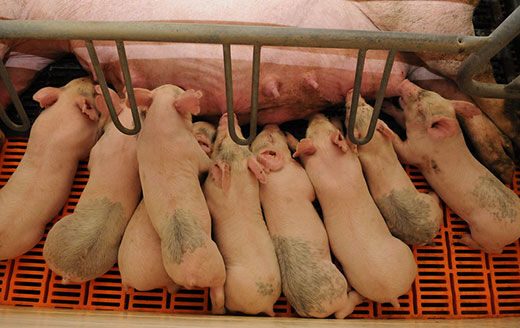Kansas State University swine researchers and graduate students are reporting findings that could help the survival rates of newly weaned pigs.
Doctoral student Madie Wensley said she recently conducted nine experiments with more than 17,000 pigs and found that body weight loss and fall out rates—two factors in preventing pig mortality—can be improved through strategic feeding and management programs.
“Specifically,” she said, “providing creep feed before weaning or mat feeding after weaning reduced pig mortality and removals. Providing sensory attractants—such as large enrichment cubes in the feeder after weaning—also helped reduce the percentage of pigs that lost weight after weaning.”
Creep feeding is a method of supplementing a young animal’s diet by offering feed while they are still nursing. Mat feeding involves spreading a small amount of feed on floor mats near the feeders, which has been shown to stimulate pigs to eat more.
“Pig livability is an important metric for the swine industry, both from a welfare and an economic standpoint,” said Mike Tokach, University Distinguish Professor in K-State’s Department of Animal Sciences and Industry.
Tokach said K-State is in partnership with Iowa State and Purdue on a five-year grant funded by the National Pork Board and the Foundation for Food and Agriculture Research to reduce mortality in the swine industry. As much as one-third of pigs that are born do not make it to market; the largest percentage of those die at birth or before weaning.
“Two of the greatest times when mortality occurs are within 48 hours after birth, and the first two weeks after weaning,” he said.
Wensley said her research tested numerous feeding and management strategies to help better prepare young pigs for weaning, “which is arguably the most stressful event a pig faces in its lifetime,” she said.
“The overarching goal of these experiments was to increase feed accessibility and recognition by encouraging pigs to explore their environment; encourage them to begin consuming feed earlier; and increase survivability after weaning.”
Wensley and Tokach will be presenting their findings during K-State’s annual Swine Day, which is scheduled for Nov. 18 in Manhattan. Registration for this year’s event costs $25 and is available online at https://www.asi.k-state.edu/events/swine-day or interested persons may contact Lois Schreiner by email at [email protected].
“The research I have been involved in during my doctoral program is practical,” Wensley said. “I can take the work I have done to the farm level and help animal caregivers implement and understand its importance. Ultimately, that’s why I went to graduate school to study swine nutrition; I want to help people be more successful. I think this research gives producers the opportunity to do so.”




